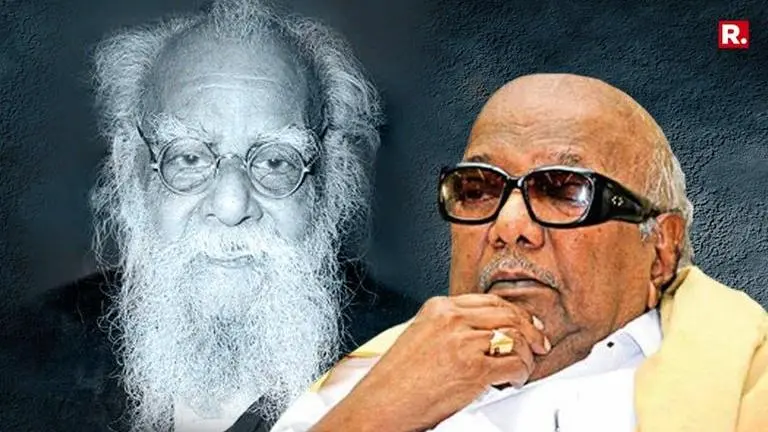Updated 8 August 2018 at 01:09 IST
Here's all you need to know about the Dravidian movement of South India of which Karunanidhi was a flagbearer
DMK Supremo M. Karunanidhi was among the flagbearers of the Dravidian movement in South India
- India News
- 0 min read

The year 2017 marked 50 years of uninterrupted rule of the Dravidian parties of Tamil Nadu, which includes the Dravida Munnetra Kazhagam (DMK) and the All India Anna Dravida Munnetra Kazhagam (AIADMK). The parties, which have been rivals since the latter was founded in the 70s, however, have the same roots which date back to the Dravidian movement.
The self-respect movement, aka the Dravidian movement, was based on the ideologies of the Justice Party that was formed in 1916 by T.M.Nair and P. Theagaraya Chetty. The party comprised of upper-class non-Brahmins who were from land-owning agricultural castes and merchants. The party focussed on removing Brahmins from high positions in the Government.
In 1920, the Justice Party won the first direct election in the presidency and formed the government for the next 13 years. In 1937, after it lost to the Congress, Periyar took over the leadership of the party. Following this, in 1944, Periyar withdrew the party from electoral politics and declared it as a social organization.
The Dravidian Movement, better known as “Arivu Viduthalai Iyakkam" was started to revolt against the Brahmin dominance in the four Dravidian states of South India.
Small movements were held by thinkers and other organizations from the 1930s to the 1950s which contended that South Indians constituted an entity, in terms of culture as well, that was different from North Indians. The Dravidian movement also claimed that Brahmins were originally from the north and that they had imposed Sanskrit, religion, and their heritage on the people of South India.
Advertisement
In its early stages, the Dravidian movement was led by Periyar E. V. Ramaswamy who had demanded an independent Dravidian state, which would comprise of all the Dravidian-speaking states of South India.
Periyar's movement was based on three ideologies: dismantling of Brahmin hegemony; revitalization of the "Dravidian Languages" (that include Telugu, Kannada, Malayalam, and Tamil) and social reform by the abolition of existing caste systems, religious practices and recasting women's equal position in the society.
Apart from the resentment against the dominance of Brahmins, the Dravidian movement also gave high importance to feminist values. In Periyar's model of society, women's rights over their physical, sexual and reproductive choices were celebrated. Women were also allowed access to contraception and even permanent birth control measures.
The self-respect movement gained popularity across the country for its beliefs such as the encouragement of inter-caste marriages which replaced arranged marriages constrained by the caste system. Additionally, the movement also focussed on 'self-respect marriages' which were conducted without a Brahmin priest. As a result, Tamil Nadu became the first state to legalize Hindu marriages conducted without a Brahmin priest. This was the first file that was signed by CN Annadurai when DMK came into power in 1963.
Advertisement
In 1947, after India gained independence, Periyar had called for the members of Dravidar Kazhagam to boycott the celebrations. He believed that the Indian Congress was dominated by the Brahmins. Hence, the oppression of the British would be replaced by the oppression of Brahmins. This move saw resentment from former Chief Minister of Tamil Nadu CM Annadurai who was a part of the organization.
As the organization gained popularity, several members within the organization felt the need to contest elections. However, Periyar maintained his ideologies and said that politics will force ideology into the background. Periyar's marriage to Maniammai (who was forty years younger) in 1948 added to the internal conflicts and led to the split of the organization. Thus the Dravida Munnetra Kazhagam was born, which consisted of all the members of the Dravidar Kazhagam who wanted to contest elections.
At the age of 33, Karunanidhi entered the Tamil Nadu assembly by winning the Kulithalai seat in the 1957 election. He became the DMK treasurer in 1961 and deputy leader of opposition in the state assembly in the year 1962 and when the DMK came to power in 1967, he became the Minister for Public Works.
After the death of CM Annadurai in 1969, M Karunanidhi took over as the Chief Minister of Tamil Nadu following which he was elected in 1971, 1989, 1996 and in 2006.
During the National Emergency, Karunanidhi led DMK government was the only one who opposed the move by former Prime Minister Indira Gandhi.
Published By : Anirudh Sunilkumar
Published On: 7 August 2018 at 23:37 IST
